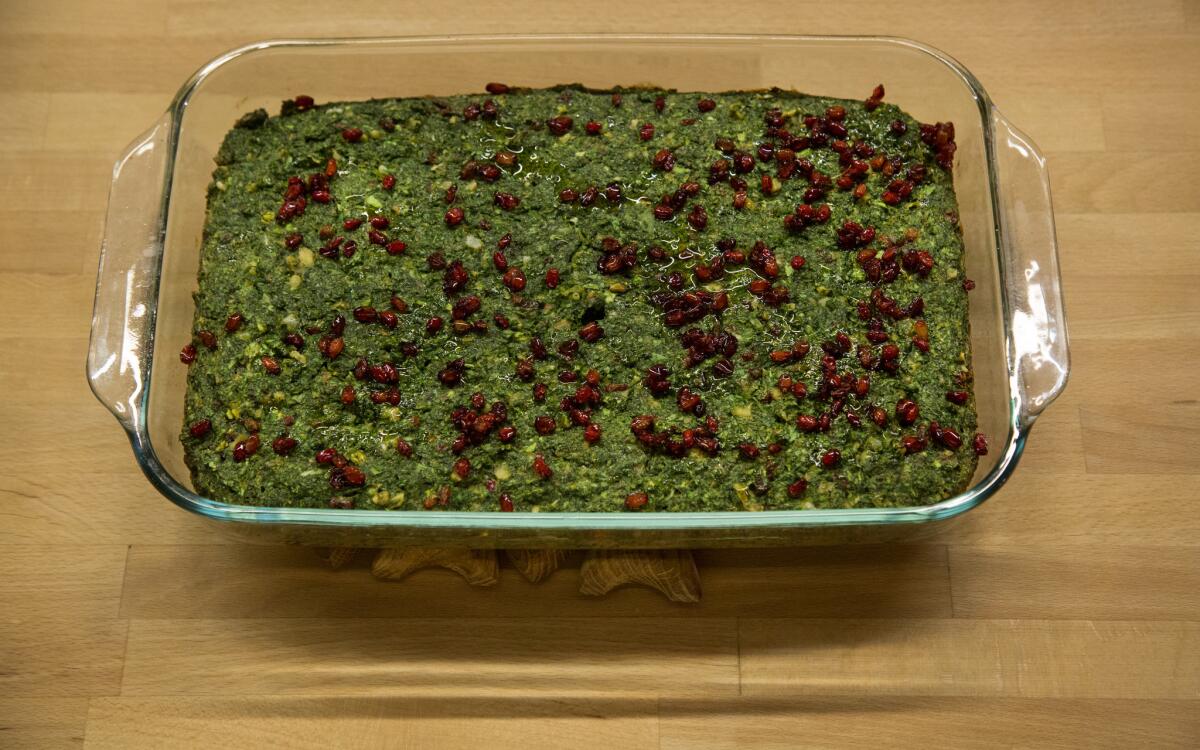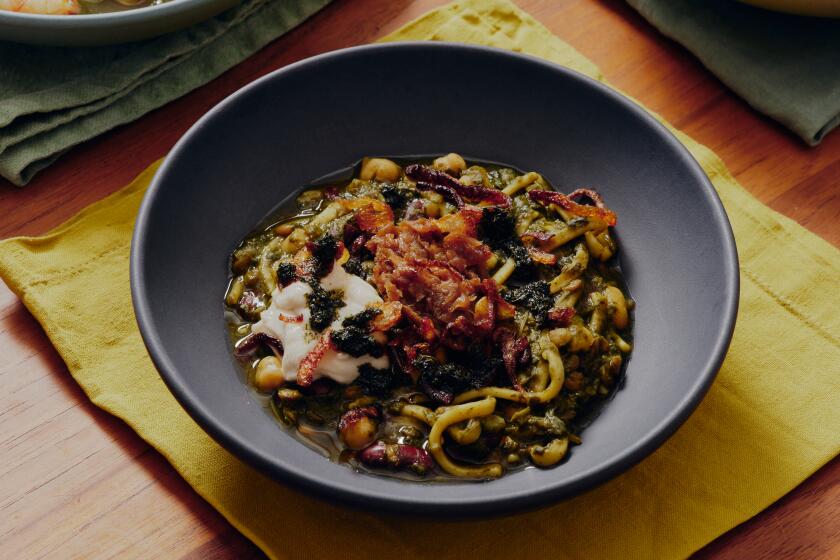Fresh herb kuku (kuku-ye-sabzi)

- Share via
On Sunday, 71-year-old Shamsi Katebi will be in her West Los Angeles kitchen, bossing around one of the best chefs in the city. She’s the mother-in-law of Tony Esnault, chef-owner of the downtown restaurants Spring and Church and State. Her daughter is Esnault’s wife and business partner, Yassmin Sarmadi. Katebi is also the matriarch of an Iranian American family, tasked with preparing a traditional meal for Nowruz, the Persian and Zoroastrian New Year.
For Iranians, the 13-day festivities — Nowruz, also spelled Nerwoz or Noroz, translates to “new day” in Farsi — begin at the exact moment that spring starts. This year, it’s at precisely 3:28 a.m. on Monday morning. The holiday, also considered a holy time for Zoroastrians, is celebrated by Kurds, Tajiks and Afghans, among other cultures. And the exact time and date of the New Year can vary based on who is celebrating, and where.
A few weeks before the holiday, Katebi is in Esnault and Sarmadi’s downtown loft kitchen, preparing three dishes that she and Esnault plan to make together at Spring — Esnault and Sarmadi’s year-old French restaurant — for a special Nowruz tasting menu. A slow cooker full of turmeric-spiced lamb steams on the stove-top, an herb-heavy dish called kuku-ye-sabzi bakes in the oven. Katebi has just started on one of the two rice dishes she plans to serve for the holiday, both at the restaurant and at home.
Katebi wears a crisp white shirt, the back of her collar popped, and her blond hair is short, the perfectly coiffed strands falling just below her ears. Her posture is noticeably poised — she stands up straight, even as she tends to the rice on the stove.
Katebi moved to the U.S. from Tehran with her husband and two children more than four decades ago. She holds two degrees from schools in Iran, and received two more, including a PhD, from the Claremont Colleges. She spent most of her career in the U.S. working as a librarian, but says that since the day she married, at 21, she has always cooked for her family. Although Katebi has never been a professional chef like her son-in-law, she’s been cooking the new year dinner for her family for the last 42 years.
This year, as she has the years before, she’ll be making sabzi polow ba mahi, fried and smoked white fish with crispy rice layered with herbs. It’s a dish traditional to Nowruz, and one Katebi learned to make from her mother more than a half-century ago, when she started cooking in Tehran. It is not a dish you will often find at Iranian restaurants in America, where most of the entrees consist of meat kebabs and rice.
“My mother was an excellent cook and well known among the family,” says Katebi. “She made everything from scratch, making all her own pickles, jams, everything, and she was an excellent teacher.”
Katebi is also making a toasted noodle and rice dish with lamb, dates and raisins called reshteh polow, and a baked herb, walnut and barberry dish called kuku-ye-sabzi. She and Esnault are trying to figure out how to translate this family meal, made in portions large enough to feed a small army, into a tasting menu appropriate for the restaurant.
“Put a little more color on the fish,” Katebi tells Esnault, happy to have one of the best chefs in the country help with her family meal. Esnault worked with Alain Ducasse in New York and Monte Carlo before moving to Los Angeles to become executive chef at Patina, then at Church and State and most recently opening Spring.
“Tony always helps with the fish because he’s just the best when it comes to fish and everything,” says Katebi. “He’s an excellent chef. I make the rice. We’re a good team.” Meanwhile, Esnault is preparing the fried fish for the sabzi polow ba mahi, meant to be eaten on New Year’s day.
In most cuisines, the rice supports the main attraction. For Katebi, the rice is given special treatment, rinsed until clean, blanched in boiling water then rinsed again, mounded in a pot to steam, then cooked until the tahdig, a crispy layer on the bottom, is formed.
Shamsi layers the rinsed and blanched rice into a heavy nonstick pot, adding a spoonful at a time, then some herbs. She treats the rice with great care, coming back to check its progress often, making sure the steam escapes from the top of the pot is just so. The finished dish is a bright, earthy mix of dill, cilantro, parsley and chives with the fluffy and crispy rice. It’s a plate of food that celebrates the fresh produce, two preparations of fish and a multitude of textures.
“At the beginning, I was measuring everything, asking my mother, looking at her recipes,” says Katebi. “But after 50 years of cooking, I don’t need to measure. I do everything with my eyes.”
On the long wooden counter, which spans the length of Sarmadi and Esnault’s kitchen, are bunches of dill, cilantro, parsley, fenugreek, green onion and a head of romaine lettuce. All of the herbs in the sabzi polow ba mahi and the kuku celebrate spring and signify the change in the season, but Sarmadi says the main reason for these specific dishes is “as simple as tradition.” It’s what her mother, her mother’s mother and her mother’s grandmother have been making in the family for years.
“My mom has always been very good at preserving tradition, so regardless of where we were, any time of day or night, we would wake up for the New Year,” says Sarmadi, as she uses a mortar and pestle to turn saffron threads into a powder. “She’s very precise about when and how everything is done and presented.”
Part of that presentation includes the sofreh-ye-haft sin, also known as the “seven S spread,” a ceremonial setting on a table or floor that includes seven sacred Iranian dishes and items meant to represent rebirth, fertility, joy, health, beauty and nature. At Esnault and Sarmadi’s apartment, Katebi has set a table with dishes of sabzeh (sprouted wheat, lentil or mung beans), samanu (sweet pudding), senjed (sweet, dried fruit), somagh (sumac), sib (apple), sir (garlic) and serkeh (vinegar). A gold fish in a bowl symbolizes fertility, a sour orange in a bowl of water represents the earth, a stack of gold coins symbolizes prosperity and wealth, and a dish full of wild rue (esfand) is meant to keep unquiet spirits at bay.
Then there are the sweets, Persian baklava, sugar-coated almonds, marzipan and cookies, all meant to be enjoyed after the New Year. But the most important part of Katebi’s table is a poetry book by Iranian mystical poet Hafez. It’s tradition for Katebi and her family to read poems from the book around the table, just before and after the New Year. (More religious families may read instead from the Koran, or have other traditions.)
Katebi hands two onions to Esnault to chop, then starts to re-cut the pieces of finished lamb that the chef has already sliced into smaller pieces to be served. At each suggestion from his mother-in-law, Esnault gives her a patient smile, then dutifully gets to work on his latest task.
“I feel like I’ve arrived in a new family and I’m learning new cooking techniques and flavors and tradition,” says Esnault as he chops the onions. “I have a lot of respect for the food and I understand how people are with their recipes. I don’t want people to mess with my recipes,” he says with a laugh.
Sarmadi sets the table, placing a dish of herbs and radishes on one end, her mother’s homemade yogurt on another. Not only does Katebi make her own yogurt, she also makes her own pickled garlic and vegetables, also known as torshi. She soaks the produce in apple cider vinegar then lets them sit for months — or even years — at a time.
Katebi ladles the reshteh polow onto a serving platter, the rice the color of gold, then motions for Esnault to help her arrange the lamb around it. Then she turns her attention to the sabzi polow ba mahi, scooping the rice with herbs onto a platter, placing the crispy shards on top, while Esnault spoons a mixture of saffron and hot water onto the pieces of fried fish, giving each of them a splash of liquid the color of burnt orange.
At the center of the table, the rice, the fish, the lamb on top of the toasted noodles and rice, and the kuku-ye-sabzi, a bright green herb cake baked with eggs, chopped walnuts and sour barberies. The cake is light and cloud-like; it tastes like an entire garden of herbs. And the turmeric-heavy lamb has a mellow sweetness from the dried fruit in the rice.
This trio working together in the kitchen may turn into more of a permanent arrangement than the New Year tasting menu dinners, planned for the last three days of March. Esnault and Sarmadi say that with Katebi’s help, they’re planning to open two Iranian restaurants here in Los Angeles, a project they’ve been discussing for years. One will be a Chelokababi-style kebab restaurant, similar to most of the Iranian restaurants in the U.S., where the menu mostly consists of kebab plates. The other will be more like restaurants in Iran, which will serve the dishes and stews — no kebabs — as they’re cooked in traditional Iranian homes.
“There’s such an enormous Iranian population here and there’s nothing like that,” says Sarmadi. “All the recipes will come from my mom.”
Katebi has also been busy working on a book of recipes to give to Esnault and Sarmadi for the new restaurants. Since retiring three years ago from her job as a librarian at a school in Brentwood, she hasn’t slowed down a bit. And when the New Year comes, even at 3:28 a.m., after a full day of cooking for the family, she says she’ll be up, ready to celebrate.
“We will recite poetry. Then hugs and kisses. Then eat lots of sweets,” she says with a laugh. “Because it’s in the middle of the night.”
Heat the oven to 400 degrees.
In a skillet, heat one tablespoon oil over medium heat and stir fry 1/2 cup barberries until they are shiny and slightly plump, 10 to 20 seconds, careful not to burn. Remove from heat and set aside to use later as a garnish.
In a mixing bowl, beat together the eggs, salt, pepper, flour, baking powder and advieh. Stir in the chopped parsley, cilantro, dill, fenugreek, green onions, garlic, lettuce, walnuts and remaining barberries.
Heat the remaining oil in an ovenproof baking dish in the preheated oven for 5 minutes.
Take the baking dish out of the oven and pour the egg mixture in the dish. Bake until set and lightly colored, 20 to 30 minutes. Remove and set aside for 5 minutes to give the kuku time to set up.
To serve, loosen the sides with a knife, cut to desired pieces and serve it in the baking dish or invert it onto a serving platter and cut into pieces to serve. Garnish with barberries.
Get our Cooking newsletter.
Your roundup of inspiring recipes and kitchen tricks.
You may occasionally receive promotional content from the Los Angeles Times.
















